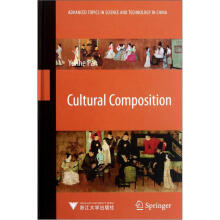文化构成(英文版)

目 录内容简介
1 Composition Design
1.1 Nature of Composition Design
1.2 Development of Composition Design
2 Meaning of Culture
2.1 Significance of Culture
2.2 Material Culture and Non-Material Culture
2.3 Various Properties of Culture
2.3.1 Diachronism
2.3.2 Nationality
2.3.3 Region
2.3.4 Multi-media
2.3.5 Contextuality
2.3.6 Evolution
2.3.7 Blending
2.3.8 Tropism
2.4 Research on Culturology
2.5 Beauty of Culture
Bibliography
3 Elements of Culture
3.1 Elements of Chinese Culture
3.1.1 CulturalElements
3.1.2 Chinese Cultural Elements
3.2 Chinese Characters and Calligraphy
3.2.1 Development of Chinese Characters
3.2.2 Calligraphy
3.3 Seal Cutting
3.4 FineArts
3.4.1 Painting
3.4.2 Sculpture
3.5 Drama and Costumes
3.5.1 Drama
3.5.2 Trappings with Chinese Characteristics
3.6 Architecture
3.6.1 Characteristics of the Traditional Chinese Architectures
3.6.2 Palaces and Imperial Architecture
3.6.3 Religious Buildings and Temples
3.6.4 Landscape Gardens
3.6.5 Residential House
3.6.6 Pagodas and Others
3.7 Appliances
3.7.1 Furniture
3.7.2 Means of Transport
3.7.3 Lacquer Works and Other Containers
3.7.4 Stationery as well as Other Items
3.7.5 Tools
3.8 Handicrafts
3.8. 1 Pottery and Porcelain
3.8.2 Bronzewares
3.8.3 JadeWare
3.8.4 Toys
3.8.5 Paper-cut and Shadow Play
3.8.6 Cloisonn6
3.9 Folk Customs
Bibliography
The Structure of Cultural Elements
4.1 Analysis of the Difference between Cultural Elements and
Geometric Elements
4.2 Hierarchical Structure of Cultural Elements
4.3 Type Structure of Cultural Elements
4.4 Symbol Structure of Cultural Elements
4.4.1 Analyzed from the Relationship between Form and Meaning, Cultural Elements Are a Kind of Symbol
4.4.2 Cultural Elements Have Complicated Parts Called"Signifier" and "Signified"
4.4.3 The Formation Design of Cultural Elements Is a Kind of Formation Design ofBoth the Signifier and the Signified
4.5 The Multiple Attributes of Cultural Elements
4.5.1 Double-Form Attribute of Cultural Elements
4.5.2 The Double Meaning Attribute of Cultural Elements
4.5.3 Analysis and Application of Attributes of Cultural Elements
Bibliography
5 Methodology of Cultural Composition
5.1 Basis of Cultural Composition: Element Transformation
5.2 Composition of a Literary Quotation
5.2.1 Quotations from Chinese Literature
5.2.2 Functions of Literary Quotation
5.2.3 Methods of Literary Quotation
5.2.4 Conform to Non-conventional Patterns
5.2.5 Embedded Literary Quotation
5.3 Contrast Composition
5.3.1 Contrast between Ancient Times and Modern Times
5.3.2 Contrast between China and Western Countries
5.3.3 Contrast between Reality and the Virtual World
5,4 Exaggerated Composition
5.5 Aggregation in Composition
5.6 Misalignment Composition
5,7 Coordination Composition
5.7.1 Coordination of the Same Quality
5.7.2 Abstract Coordination
5.7.3 Alternation Coordination of Texture and Color
5.7.4 Coordination of the Space Complement
5.7.5 Fusion Coordination
5.8 The Soul of Cultural Composition: [roagery
5.9 Comparison of Cultural Composition Methodologies
Bibliography
6 Principles and Value of Cultural Design
6.1 The Cognition Approaches to and Principles of Cultural Design
6.1.1 The Cognition Approaches to Cultural Design
6.1.2 Principles of Cultural Design
6,2 Cultural Value Elements of Design
6.3 National Culture Is the Unique Resource for the Cultural Design of This Nation
Bibliography
Index
Postscript
1.1 Nature of Composition Design
1.2 Development of Composition Design
2 Meaning of Culture
2.1 Significance of Culture
2.2 Material Culture and Non-Material Culture
2.3 Various Properties of Culture
2.3.1 Diachronism
2.3.2 Nationality
2.3.3 Region
2.3.4 Multi-media
2.3.5 Contextuality
2.3.6 Evolution
2.3.7 Blending
2.3.8 Tropism
2.4 Research on Culturology
2.5 Beauty of Culture
Bibliography
3 Elements of Culture
3.1 Elements of Chinese Culture
3.1.1 CulturalElements
3.1.2 Chinese Cultural Elements
3.2 Chinese Characters and Calligraphy
3.2.1 Development of Chinese Characters
3.2.2 Calligraphy
3.3 Seal Cutting
3.4 FineArts
3.4.1 Painting
3.4.2 Sculpture
3.5 Drama and Costumes
3.5.1 Drama
3.5.2 Trappings with Chinese Characteristics
3.6 Architecture
3.6.1 Characteristics of the Traditional Chinese Architectures
3.6.2 Palaces and Imperial Architecture
3.6.3 Religious Buildings and Temples
3.6.4 Landscape Gardens
3.6.5 Residential House
3.6.6 Pagodas and Others
3.7 Appliances
3.7.1 Furniture
3.7.2 Means of Transport
3.7.3 Lacquer Works and Other Containers
3.7.4 Stationery as well as Other Items
3.7.5 Tools
3.8 Handicrafts
3.8. 1 Pottery and Porcelain
3.8.2 Bronzewares
3.8.3 JadeWare
3.8.4 Toys
3.8.5 Paper-cut and Shadow Play
3.8.6 Cloisonn6
3.9 Folk Customs
Bibliography
The Structure of Cultural Elements
4.1 Analysis of the Difference between Cultural Elements and
Geometric Elements
4.2 Hierarchical Structure of Cultural Elements
4.3 Type Structure of Cultural Elements
4.4 Symbol Structure of Cultural Elements
4.4.1 Analyzed from the Relationship between Form and Meaning, Cultural Elements Are a Kind of Symbol
4.4.2 Cultural Elements Have Complicated Parts Called"Signifier" and "Signified"
4.4.3 The Formation Design of Cultural Elements Is a Kind of Formation Design ofBoth the Signifier and the Signified
4.5 The Multiple Attributes of Cultural Elements
4.5.1 Double-Form Attribute of Cultural Elements
4.5.2 The Double Meaning Attribute of Cultural Elements
4.5.3 Analysis and Application of Attributes of Cultural Elements
Bibliography
5 Methodology of Cultural Composition
5.1 Basis of Cultural Composition: Element Transformation
5.2 Composition of a Literary Quotation
5.2.1 Quotations from Chinese Literature
5.2.2 Functions of Literary Quotation
5.2.3 Methods of Literary Quotation
5.2.4 Conform to Non-conventional Patterns
5.2.5 Embedded Literary Quotation
5.3 Contrast Composition
5.3.1 Contrast between Ancient Times and Modern Times
5.3.2 Contrast between China and Western Countries
5.3.3 Contrast between Reality and the Virtual World
5,4 Exaggerated Composition
5.5 Aggregation in Composition
5.6 Misalignment Composition
5,7 Coordination Composition
5.7.1 Coordination of the Same Quality
5.7.2 Abstract Coordination
5.7.3 Alternation Coordination of Texture and Color
5.7.4 Coordination of the Space Complement
5.7.5 Fusion Coordination
5.8 The Soul of Cultural Composition: [roagery
5.9 Comparison of Cultural Composition Methodologies
Bibliography
6 Principles and Value of Cultural Design
6.1 The Cognition Approaches to and Principles of Cultural Design
6.1.1 The Cognition Approaches to Cultural Design
6.1.2 Principles of Cultural Design
6,2 Cultural Value Elements of Design
6.3 National Culture Is the Unique Resource for the Cultural Design of This Nation
Bibliography
Index
Postscript
目 录内容简介
《文化构成(英文版)》阐述了设计创新的文化构成之路,全书从构成设计、文化的含义、文化的元素、文化元素的结构、文化构成的方法、文化设计的原则和价值六个方面系统分析了文化的构成结构。并用了大量有关文化素材的图片以阐明文化构成的原理。《文化构成》是作者在多年的研究与教学基础之上逐渐提炼而成,向设计和文化工作者展示了一条创新之路,并对中国文化中的视觉元素进行了简约而有系统的分析,是一本阐述文化和设计的好书。可供建筑设计、工业设计、艺术设计类专业的设计师、教师、学生和研究人员参考。
比价列表
1人想要
公众号、微信群
 缺书网
缺书网微信公众号
 扫码进群
扫码进群实时获取购书优惠




